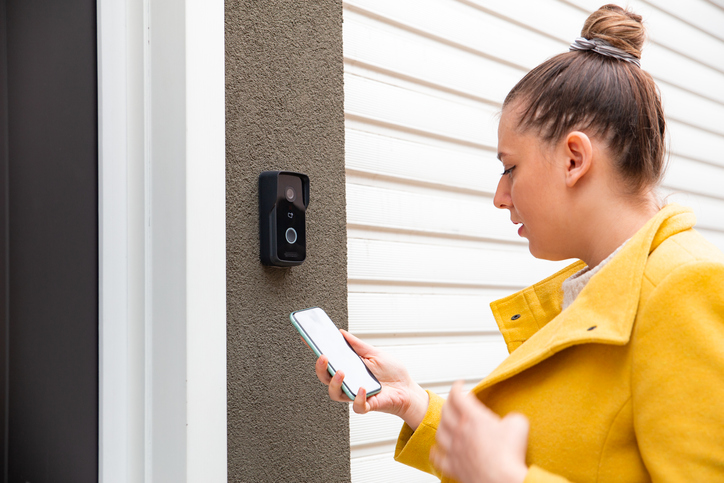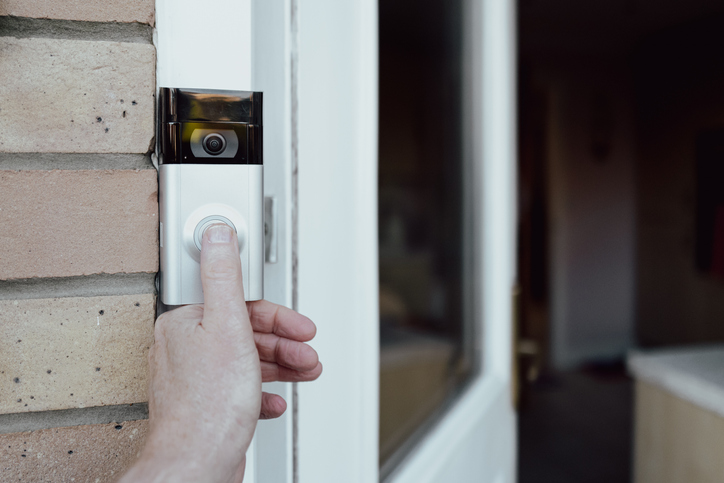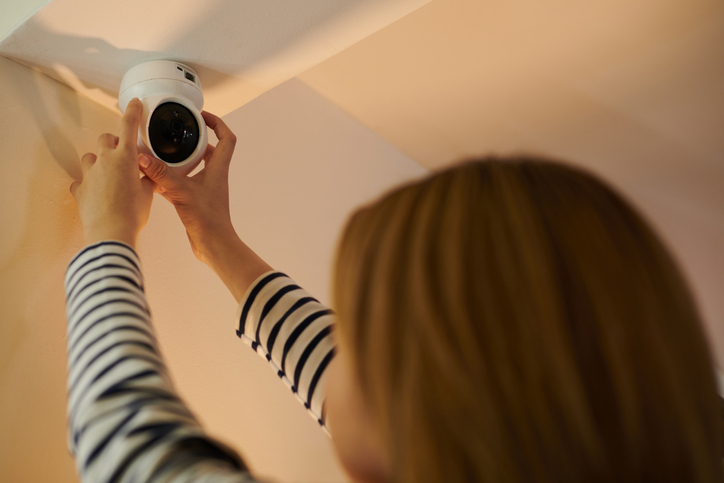Video doorbells have emerged as a modern and innovative solution to enhance home security. By combining advanced technology, convenience, and connectivity, video doorbells provide homeowners with a comprehensive approach to monitoring and protecting their homes. With features like live video streaming, motion detection, two-way communication, and integration with smart home systems, video doorbells offer a new level of awareness, convenience, and peace of mind. In this article, we will explore the functionality, benefits, key features, and considerations of video doorbells, highlighting their role as a modern approach to home security.

Understanding Video Doorbells
Video doorbells are innovative devices that combine a doorbell with a built-in camera, enabling homeowners to see and communicate with visitors remotely. These devices are typically installed near the front door and are connected to a home’s Wi-Fi network. When someone approaches the door, the camera on the video doorbell detects motion or activates when the doorbell button is pressed, capturing video footage of the visitor.
The captured video is then transmitted to the homeowner’s smartphone, tablet, or computer, allowing them to see a live video feed or receive recorded video clips. This real-time access provides homeowners with the ability to identify and interact with visitors, even when they are not physically present at home.
The primary purpose of video doorbells is to enhance home security and provide homeowners with a sense of control and peace of mind. They act as a first line of defense, allowing users to visually verify the identity of visitors and determine whether it’s safe to open the door. By combining video surveillance and two-way communication capabilities, video doorbells offer an effective means of monitoring and managing access to the home.
Benefits Of Using Video Doorbells For Home Security
Video doorbells offer significant benefits for home security. They act as a deterrent, discouraging potential burglars with their visible presence and the knowledge that their actions are being recorded. Video doorbells provide enhanced awareness by allowing homeowners to see and communicate with visitors in real time, even when they are not at home. This empowers homeowners to make informed decisions about opening the door and helps them stay vigilant against suspicious activity.
Remote monitoring is a key advantage of video doorbells. Homeowners can access live video feeds and receive alerts on their smartphones or other devices, enabling them to keep an eye on their front door from anywhere. This feature is especially useful for monitoring deliveries, allowing users to communicate with delivery personnel or provide specific instructions for package drop-offs. It helps prevent package theft and ensures the security of valuable deliveries.
Video doorbells also offer peace of mind by providing a sense of security and control. Homeowners can monitor their property, screen visitors, and keep an eye on children or pets playing outside. Additionally, video doorbells can integrate with other smart home devices, creating a comprehensive security ecosystem. By combining their capabilities with other systems such as door locks, security cameras, and voice assistants, video doorbells enhance overall home security, providing convenience and peace of mind to homeowners.
Key Features And Considerations
When selecting a video doorbell for your home security needs, it’s important to consider several essential features:
- High-Quality Video – Look for a video doorbell that offers high-definition (HD) video resolution. This ensures clear and detailed footage, allowing you to easily identify people at your door.
- Two-Way Audio – The ability to communicate with visitors is crucial. Ensure that the video doorbell has built-in speakers and a microphone for two-way audio communication. This feature enables you to speak to visitors or delivery personnel without having to open the door.
- Motion Detection and Alerts – Opt for a video doorbell with reliable motion detection capabilities. It should be able to detect movement and send instant alerts to your smartphone or other devices when someone approaches your door. Customizable alert settings allow you to personalize the sensitivity and notification preferences.
- Night Vision – Consider a video doorbell equipped with infrared (IR) or other night vision technology. This ensures clear visibility even in low-light or nighttime conditions, allowing you to monitor your front door 24/7.
- Wide-Angle Lens – Look for a video doorbell with a wide-angle lens that provides a broad field of view. A wider viewing angle allows you to see more of your doorstep and surrounding areas, minimizing blind spots.
Compatibility With Existing Security Systems
When choosing a video doorbell for your home, it’s important to consider its compatibility with your existing security systems. Integration between the video doorbell and other security devices can provide a more comprehensive and cohesive security solution.
If you already have surveillance cameras installed around your property, ensure that the video doorbell is compatible with your camera system. This compatibility allows you to access and control all your cameras from a single app or platform, providing a unified view of your home’s security. Check if the video doorbell can integrate with your existing alarm system. This integration allows you to receive alerts and trigger alarms based on the video doorbell’s motion detection or when the doorbell button is pressed. It enhances the overall security of your home by synchronizing video surveillance with your alarm system.
Some homeowners opt for professional monitoring services offered by security companies. If you have such a service, ensure that the video doorbell can be seamlessly connected to the monitoring system. This integration enables the security company to receive alerts and access video footage in the event of an emergency, improving its ability to respond effectively. If you use video management software to manage and organize video feeds from multiple cameras, confirm that the video doorbell can be integrated into your existing VMS. This allows you to have a centralized platform for accessing and managing all your video footage, simplifying the monitoring and playback process.
If you have an access control system, such as electronic locks or keyless entry systems, look for a video doorbell that can integrate with it. This integration enables you to remotely grant access to visitors through the video doorbell’s two-way audio and video capabilities, providing a seamless and secure entry experience.
Installation And Operation Of Video Doorbells
Video doorbell installation can be done through DIY methods or professional installation services. DIY installation offers convenience and cost savings, while professional installation provides expertise and support. Remote access from smartphones or computers enables homeowners to monitor and control their video doorbells from anywhere, enhancing convenience and security.
DIY Installation Options
Many video doorbells are designed for easy do-it-yourself (DIY) installation, allowing homeowners to set them up without the need for professional assistance. DIY installation offers convenience and cost savings. Here are some key aspects of DIY installation:
- Mounting – Video doorbells are typically installed near the front door, and most models come with the necessary mounting hardware. Installation usually involves attaching the video doorbell to the wall or door frame using screws or adhesive strips. Clear instructions and templates are provided to ensure proper placement and alignment.
- Wiring or Battery Operation – Video doorbells can either be hardwired or battery-powered. Hardwired video doorbells require connecting the device to existing doorbell wiring or directly to a power source. Battery-operated models, on the other hand, are powered by rechargeable batteries, eliminating the need for wiring. DIY installation offers flexibility to choose the option that best suits your needs and resources.
- Wi-Fi Setup – To connect the video doorbell to your home network, you’ll need to follow the manufacturer’s instructions for Wi-Fi setup. This typically involves using a companion mobile app to connect the video doorbell to your Wi-Fi network and create an account. The app will guide you through the steps to connect the device to your smartphone or computer.
Professional Installation Services
For homeowners seeking the convenience and expertise of professional installation, there are several companies that offer specialized services to ensure a seamless setup of video doorbells. These services come with distinct advantages and may vary in terms of pricing. Here are a few examples:
- Secure Home Installation Services – Secure Home offers professional installation services for video doorbells. With certified technicians who have extensive experience in setting up video doorbells, they provide reliable and efficient installation. Their services typically start at $99, depending on the complexity of the installation and any additional requirements.
- ProTech Security Solutions – ProTech Security Solutions specializes in home security solutions and offers professional installation services for video doorbells. Their skilled installers handle the entire installation process, ensuring proper placement, wiring, and connectivity. They provide personalized consultations to determine the ideal setup for your home’s security needs. Pricing for their installation services starts at $129.
It’s worth noting that pricing can vary based on factors such as the complexity of the installation, additional equipment needed, and geographic location. It’s recommended to contact the installation service providers directly for accurate and up-to-date pricing information.
Remote Access From Smartphones Or Computers
Remote access from smartphones or computers is a key feature of video doorbells, providing homeowners with convenience and control. This feature allows you to stay connected and monitor your video doorbell from anywhere.
Video doorbell manufacturers typically offer companion mobile apps or software specifically designed for remote access. These apps enable you to establish a connection with your video doorbell through the internet. By logging into the app or software using your account credentials, you can securely access the device remotely.
During the initial setup, you will connect the video doorbell to your home Wi-Fi network. This connection enables the video doorbell to transmit data and video footage to your smartphone or computer. The manufacturer’s app or software will guide you through the process of connecting the video doorbell to your Wi-Fi network and creating your user account.
Once the video doorbell is connected and your account is set up, you can enjoy real-time monitoring and communication. The mobile app or software will send you instant notifications when someone approaches your door or presses the doorbell button. You can then access the live video feed, allowing you to see and hear what is happening in real time. The two-way audio functionality enables you to communicate with visitors through your smartphone or computer, even if you are not physically present at home.
Capturing And Storing Video Footage On Video Doorbells
Video doorbells are equipped with various recording capabilities to capture and store video footage, ensuring important events and activities at your front door are documented. Some video doorbells offer continuous recording, capturing, and storing footage continuously to provide a comprehensive record of all activities. Others employ motion-activated recording, starting to record when motion is detected within the camera’s field of view. Additionally, video doorbells can offer event-based recording triggered by actions such as someone ringing the doorbell. These recording capabilities ensure that relevant interactions and events are reliably captured and saved for later review.
Storage Options For Video Footage
Once video footage is recorded, it needs to be stored for later access and review. Video doorbells typically offer different storage options to accommodate varying needs. Cloud storage is a common option where recorded footage is securely stored on remote servers accessible through the internet. This provides convenience as the footage can be accessed from anywhere using the manufacturer’s mobile app or web portal. Local storage is another option, allowing the footage to be saved directly to a removable memory card or built-in storage within the video doorbell itself. Some video doorbells also offer hybrid storage options, combining both cloud and local storage for added flexibility and data redundancy.
Privacy Concerns Of Video Doorbells
As the use of video doorbells becomes increasingly prevalent, it is essential to address the privacy and data protection concerns associated with these devices. Video doorbells typically provide privacy settings that allow users to customize the device’s behavior according to their specific preferences. These settings can include defining motion detection zones, adjusting sensitivity levels, and setting recording schedules. By utilizing these features, homeowners can ensure that the video doorbell focuses on areas and times that are most relevant to their security needs while respecting the privacy of neighboring properties or public areas.
Reputable video doorbell manufacturers employ encryption and other robust security measures to protect the recorded footage and ensure that it remains private. This includes secure data transmission between the video doorbell and the storage servers, as well as strong authentication protocols to prevent unauthorized access. By using encryption techniques, manufacturers minimize the risk of interception or tampering with the recorded video footage.
Many video doorbell systems provide user access controls, allowing homeowners to grant specific permissions and access privileges to other individuals. This feature enables homeowners to maintain control over who can view and manage the recorded footage. By granting access only to trusted family members, friends, or neighbors, homeowners can ensure that their privacy is protected and the recorded footage remains secure.
It is crucial to choose video doorbells from manufacturers who prioritize privacy and comply with relevant privacy regulations and data protection laws. Manufacturers should follow industry best practices, adhere to privacy guidelines, and provide transparency regarding their data handling practices. This includes clearly communicating how data is collected, stored, and shared, as well as offering options for users to exercise control over their personal information.
To further enhance privacy, some video doorbell manufacturers implement anonymization techniques to remove personally identifiable information from the recorded footage. Additionally, manufacturers should provide clear data retention policies, allowing users to define how long the recorded footage is retained before being automatically deleted. This ensures that unnecessary data is not stored indefinitely, minimizing potential privacy risks.
Homeowners should inform visitors and neighbors about the presence of a video doorbell to promote transparency and respect privacy. This can be done through visible signage or verbal communication, letting individuals know that their actions may be captured by the video doorbell. Openly discussing the purpose of the device helps foster a sense of trust and respect within the community.
Special Features Of Video Doorbells
Advanced features and integration capabilities are key aspects that set video doorbells apart in the realm of home security. These features, such as night vision, motion detection, two-way communication, and seamless integration with other security devices, enhance the functionality, convenience, and overall effectiveness of video doorbells in protecting your home and providing peace of mind.
Night Vision Capabilities For Enhanced Security At Night
Video doorbells equipped with night vision capabilities use infrared technology to capture clear video footage even in low-light or complete darkness. This feature enhances the security of your home during nighttime hours when visibility is limited. By utilizing infrared LEDs or other advanced night vision technologies, video doorbells can provide a clear view of visitors and activities at the front door, allowing you to identify individuals and ensure their safety.
Facial Recognition
Some video doorbell models offer facial recognition technology, which can identify familiar faces and alert you accordingly. This feature allows you to create a database of known individuals, such as family members or trusted friends, and receive specific notifications when they are detected at the door. Facial recognition adds an extra layer of personalization and convenience to your video doorbell, enabling you to prioritize and differentiate between familiar and unknown visitors.
Package Detection
With the rise of online shopping, package theft has become a concern for many homeowners. Certain video doorbells incorporate package detection technology that can specifically identify when a package is delivered and send you a dedicated notification. This feature helps you stay informed about your deliveries and ensures that you can promptly retrieve them, minimizing the risk of theft or damage.
Limitations and Drawbacks Of Video Doorbells
While video doorbells offer numerous benefits, they may also have limitations and challenges that need to be addressed for optimal performance. Here are some common limitations and potential solutions:
- Wi-Fi Range and Connectivity Issues – Video doorbells rely on a stable Wi-Fi connection to function effectively. However, if your Wi-Fi signal is weak or the distance between your router and the video doorbell is significant, you may experience connectivity issues. To address this, consider installing Wi-Fi extenders or mesh network systems to boost signal strength and ensure seamless connectivity throughout your home.
- False Motion Alerts – Video doorbells with motion detection capabilities may occasionally trigger false alerts due to factors like passing cars, moving shadows, or environmental changes. To mitigate false alerts, adjust the motion detection sensitivity settings, define specific motion zones to focus on areas of interest, or utilize advanced features like human detection if available. Regularly check and fine-tune these settings to strike the right balance between capturing relevant events and minimizing false notifications.
- Limited Field of View – The field of view of video doorbells varies across different models. Some may have a narrower angle, potentially leading to blind spots or limited coverage. To overcome this limitation, strategically position the video doorbell for maximum coverage and consider adding additional cameras or security devices to cover areas beyond the door’s immediate vicinity.
- Weather Resistance – Video doorbells are exposed to various weather conditions, including rain, snow, heat, and cold. Ensure that the chosen video doorbell is weather-resistant or specifically designed for outdoor use. Look for an IP (Ingress Protection) rating that indicates the level of protection against water and dust. Regularly clean and maintain the video doorbell to ensure optimal performance in all weather conditions.
Tips For Video Doorbell Common Issues
To address and mitigate common issues associated with video doorbells, consider the following tips:
- Regularly Update Firmware and Software – Manufacturers often release firmware and software updates to enhance performance, add new features, and address any known issues. Regularly check for updates through the manufacturer’s app or website and keep your video doorbell’s firmware and software up to date.
- Optimize Wi-Fi Signal Strength – Ensure that your video doorbell has a strong and stable Wi-Fi connection by positioning your router adequately and eliminating sources of interference. Consider using Wi-Fi range extenders or mesh network systems to extend coverage and improve connectivity in areas near the video doorbell.
- Understand and Customize Settings – Familiarize yourself with the settings and features of your video doorbell. Customize motion detection sensitivity, motion zones, and other relevant settings to suit your specific needs. Regularly review and fine-tune these settings to strike the right balance between capturing important events and reducing false notifications.
- Perform Regular Maintenance – Keep your video doorbell clean and free from dirt, debris, and spider webs that could obstruct the camera lens or sensors. Regularly inspect and clean the lens to ensure clear video footage. Check for any loose connections or signs of damage and address them promptly.
- Seek Technical Support – If you encounter persistent issues or challenges with your video doorbell, reach out to the manufacturer’s customer support or consult their online knowledge base for troubleshooting tips. They can provide guidance, offer solutions, or assist with warranty-related matters.
Conclusion
Video doorbells have revolutionized home security by providing a modern and effective approach to monitoring and protecting your home. Their functionality, convenience, and advanced features such as night vision, motion detection, and two-way communication make them a valuable addition to any home security system. With the ability to remotely access and control video doorbells from smartphones or computers, homeowners can enhance their peace of mind and ensure the safety of their property and loved ones. While video doorbells may have limitations and challenges, these can be overcome through proper setup, customization, and addressing common issues. By embracing video doorbells as a modern approach to home security, homeowners can experience increased awareness, deterrence of potential threats, and an overall sense of security.




